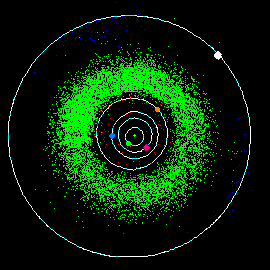


 Français
Français
THE DIFFERENT FAMILIES OF ASTEROIDS
By their composition, they also belong to different chemical classes :
Class C : carbonaceous objects very dark, witnesses of the origin of the solar system (75% of asteroids)
Class S : metallic objects (nickel, iron, magnesium silicates), the brightest (17% of asteroids)
Class M : iron objects and pure nickel, shiny (7% of asteroids)
Objects of classes S and M are the result of a shock: they are pieces of a larger body in which metals were melted.
Others classes are variants of the main classes C, S and M in which many asteroids can not be classified.
To learn how they give their names to asteroids, and what are these names, click here.
Asteroids are divided into different dynamical families
Atira (Interior Earth Objects IEO) : asteroids the orbit of which being entirely interior to the orbit of the Earth. The distance at aphelion is less than the perihelion of the Earth, i.e. 0.983 astronomical unit; we detected 28 of them, (on December 5, 2022) 8 being numbered.
Aten (Near Earth Objects) : asteroids crossing the orbit of the Earth and Venus, with a semi-major axis less than one astronomical unit (150 million kilometers) and whose aphelion is more than 0.983 astronomical unit;
Apollo (Near Earth Objects) : asteroids crossing the Earth's orbit, with a semi-major axis larger than one astronomical unit (150 million kilometers), but whose perihelion is less than 1.017 astronomical unit from the Sun;
Amor (Near Earth Objects) : asteroids crossing the orbits of the Earth and Mars, whose perihelion is more than 1.017 astronomical units but less than 1.3 astronomical unit from the Sun.
Main belt : asteroids whose orbit is between Mars and Jupiter (the largest group)
Trojans : asteroids on the orbit of Jupiter (or Mars) in advance or delay of 60 ° (Lagrange points of the orbit);
Centaurs : asteroids whose orbit is between those of Jupiter and Neptune, they are very few because the orbits are unstable;
Scattered : asteroids whose orbit extends beyond that of Neptune without dynamic link with it: there are few because the orbits are unstable;
Kuiper Belt : asteroids beyond Neptune's orbit in resonance with this planet: we know little because they are very far from Earth and very faint but they could be very numerous.




